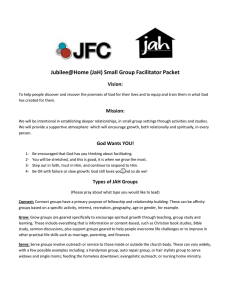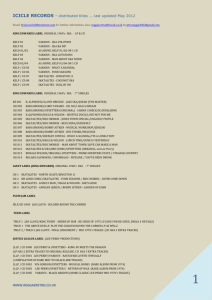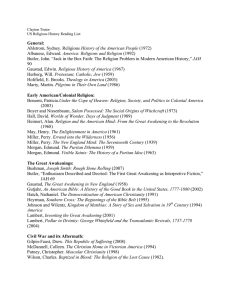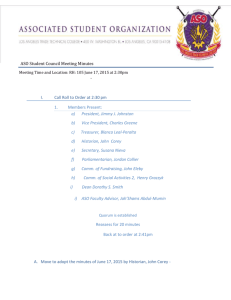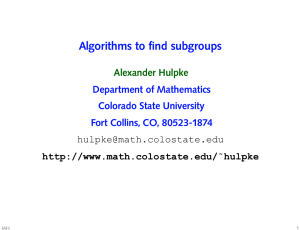GAP — System development for Computational Algebra Alexander Hulpke Department of Mathematics
advertisement
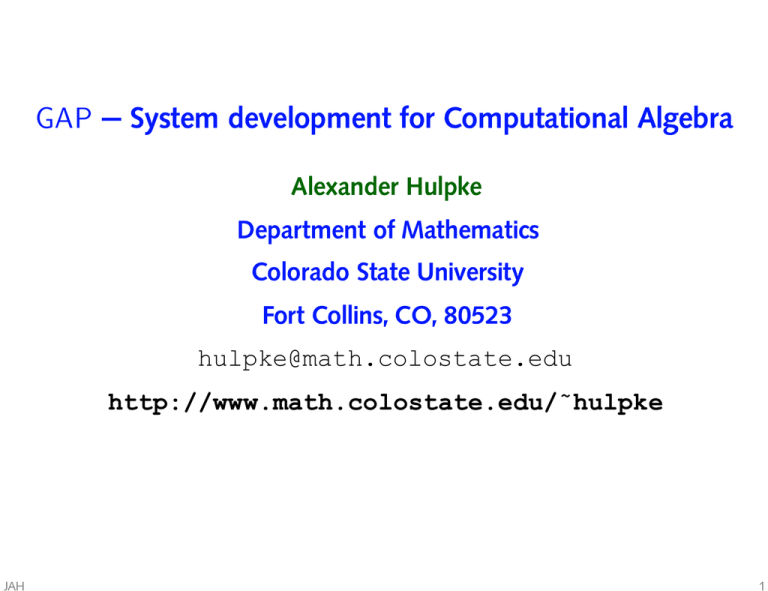
GAP — System development for Computational Algebra Alexander Hulpke Department of Mathematics Colorado State University Fort Collins, CO, 80523 hulpke@math.colostate.edu http://www.math.colostate.edu/˜hulpke JAH 1 Parts 1. What is GAP (http://www.gap-system.org) 2. Development model and -lessons 3. How can one get involved Needless to say this are all my personal opinions and I don’t neccesarily speak for every contributor to the system. JAH 2 What is GAP GAP is a free, open system for computational discrete mathematics, in particular group theory. free GAP is can be downloaded from www.gap-system.org. free GAP (as of version 4.3) is released under the GPL. open Complete Sources available. open Mechanism for third-party contributions. GAP runs on (almost) every platform. We estimate to have 1000-2000 users world-wide. Technical support is offered at gap-trouble@dcs.st-and.ac.uk, a discussion list exists at gap-forum.dcs.st-and.ac.uk. JAH 3 Features Comparatively small C-kernel provides (modeled on MAPLE) • Basic data types • Programming language (also called GAP), Memory managment • User environment Library (written in the GAP language) that provides most of the functionality. Data library (the largest part in terms of disk space). Packages. Many of them contributed from outside the GAP developer group. Setup is well-suited for algebra/combinatorics. JAH 4 Further features • An extensible type system that reflects: – Mathematical identity (matrix group over GF(9)) – Internal representation (Univariate polynomial given by coefficiens) – Acquired knowledge (found the group is solvable nonabelian) Methods can be selected automatically based on the types of all arguments. • Convenient list routines and memory managment. • Fast routines for compact matrices/vectors over finite fields. • Many “standard” routines (factorizations, combinatorics, . . . ) JAH 5 Differences to Maple &c. No analysis/calculus functionality (would be lots of work to add). Very rudimentary floating point routines. There is no support for general “terms” or “expressions”. No “unbound” variables. All expressions are evaluated and are usually in a “normal form”. Comparatively little emphasis on graphical user interface. JAH 6 Design philosophy GAP and the design and implementation of new algorithms is part of our research as mathematicians. • The code is open and free. • Principal algorithms are state-of-the-art. • The system is able to tackle research-level problems. • Time critical routines are in the kernel and thus fast. • The interpreted language provides a convenient programming environment. • We do not provide complete functionality for every perceivable task but tools with which these tasks can be done. • The system does not try to be “intelligent” JAH 7 Interfacing It is impossible to have one system do every task. There are very specialized/optimized programs for particular tasks. Thus there is need to transfer information between different systems It seems tempting to design a “grand scheme” for this, but general problems will hold up work. It seems better to start with more simple interfaces that are actually usable. Very specialized systems often anyhow need a specialized interface. Producing a rudimentary (no documentation) interface typically takes just a few hours if the function calls are clear. JAH 8 Development Model GAP started as a master’s project of 4 students. It grew initially with further masters and PhD theses. (To some extent this mimics on the setup of a German university.) We now have about 10-15 developers (varying degree of involvement). Most are now roughly at the start of an academic career (Assistant Professor level). We hope that in time we will be able again to get more students involved. Funding is as usual for academic research. Taking on tasks is basically voluntary. Packages give possibility for contributions. JAH 9 Keeping it together Developers are by now spread over the Western hemisphere. Communication is mainly via email. However people know each other and meet in smaller groups if there is opportunity. We started to slightly formalize peoples areas of work/responsibility. CVS used for code coordination. Required setup for developers is given by standard Unix. (No special development environment.) JAH 10 Advantages System adapted well to academic environment. Contributors are knowledgeable in mathematics. Students can contribute to research-level project and their contribution gets used. It is possible to write code without knowing the intricacies of C or dealing with memory managment. Authors are still around to maintain the system. Ability to develop a professional system without charging money for it: It Works JAH 11 Problems There is desirable functionality that is tedious or difficult to implement well, but for which implementation does not qualify as “research” in mathematics. (Matrix arithmetic over finite fields. I/O routines. Arbitrary precision floats. More generally: published “standard algorithms”.) It is often hard to find people who can implement such routines,are interested in doing it, and will be available in 3 years if maintainance is needed. Funding agencies are not eager to support “infrastructure” work. System might be too sophisticated for some casual users. JAH 12 Other issues Some problems are hard to solve via email. “Periodic” patterns of requests/available time. Academia does not provide a “program design” background. • Programming Style of various people. • Maintainability vs. Features/Speed. • We found a few times that we made bad decisions that were hard to reverse. JAH 13 Do not underestimate the amount of work it takes to get a usable system. JAH 14 Contributions Packages are external contributions to GAP that provide new functionality. (One can also contribute to the core but often a package requires less coordination.) It is possible to • Add kernel functionality • Interface with external binaries • Autoload seamlessly We have set up a system for refereeing such contributions. The hope is to get eventually similar credit as for a paper. There are currently about 15 refereed and 10 unrefereed packages. Contributions are often very research oriented: • “State-of-the-art” functionality. • Functionality might be in a limited area. You get contributions in what the contributors are interested in, not necessarily what you would need most. JAH 16 Who uses GAP The Developers Researchers in (Computational) group theory Researchers in other disciplines that use group theory (Mathematics, Physics, Chemistry, Computer Science) Amateurs Students (Some textbooks now involve GAP exercises) The “average” user is not a computer expert. JAH 17 Support Tasks Work that makes the program usable to other people is at least as much as getting the algorithms working. Maintainance - Correcting bugs. - Adding/Changing functionality for user tasks Wrapping new releases and releasing bugfixes User Support - Documentation - “Helpline” email. JAH 18 Frequent Requests Naı̈ve functionality for teaching or small tasks. RTFM - At least 60% of all questions could have been answered by consulting existing documentation. - But what if the documentation is bad or nonexistent? Windows look-and-feel We have a text-based interface (using cygwin). (The users who most want a better interface would have difficulties installing rxvt or similar. But I have been unable to install X11 under cygwin.) JAH 19 Most developers do not use Windows Easier Installation Brute-force calculations Users try to apply algorithms in hopeless situations. (Often mathematical insight or knowledge of the algorithm gives feasible shortcuts.) Simple programming Inertia stops some users from trying to write small routines. JAH 20 We currently maintain • CVS server • FTP server • Web server • Mailing list Why not use Sourceforge/Program XYZ Some of the setup is “old” (dates back to about 1990). “Current” technique has switched several times. Demand for particular “bespoke” features. Gain/Cost of switch often is initially very small. Changing a setup can be notable work. What happens if support for a service suddenly vanishes? JAH 21 What would be needed to extend the user community • More “How-To” documentation. • Better Windows interface • Better Floating Point Arithmetic. • Extended functionality JAH 22
